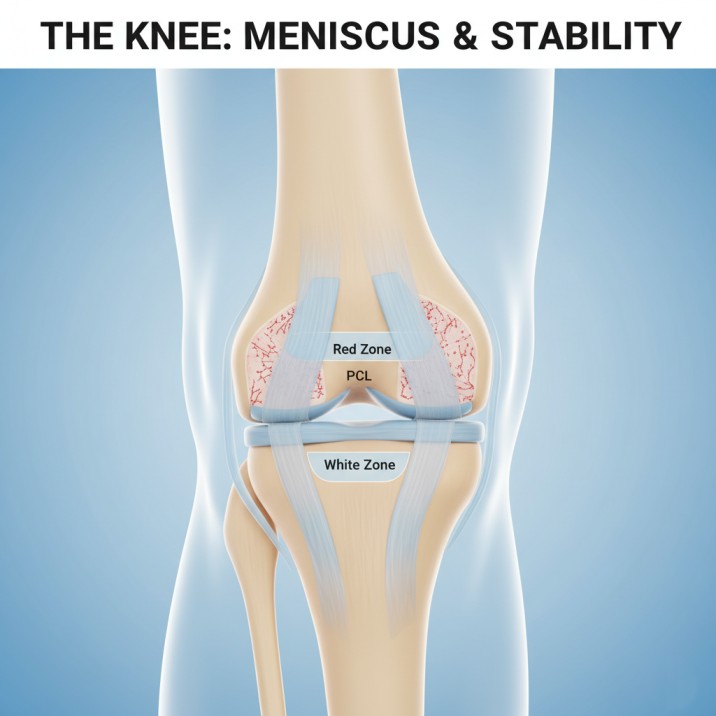Does A Torn Meniscus Require Surgery?
A sudden twist during a football match, a deep squat at the gym, or even just an awkward step off a curb—these are common moments that can lead to a sharp, distinct pain in the knee. The culprit is often a torn meniscus, one of the most frequent knee injuries seen by orthopaedic surgeons. The moment you hear the diagnosis, one critical question immediately comes to mind: Does a torn meniscus require surgery?
For anyone experiencing the pain and uncertainty of this injury, the path forward can seem confusing. The internet is filled with conflicting advice, leaving you to wonder if rest and physical therapy will be enough, or if an operation is inevitable. The truth is, there is no single “yes” or “no” answer. The right treatment depends entirely on you, your knee, and your future goals.

To navigate this complex decision, we have created this comprehensive guide. We will explore the function of the meniscus, how it tears, when non-surgical treatments are effective, and the clear signs that indicate surgery is necessary. Guiding us through this topic is Dr. Hesham Al Khateeb, an award-winning, UK-board certified Hip and Knee Surgeon in Dubai. With extensive fellowship training and over 2,000 successful joint procedures, Dr. Al Khateeb provides the expert insights needed to understand your options for a torn meniscus and get back to an active, pain-free life.
Understanding Your Knee's "Shock Absorber": What is the Meniscus?
Before we can decide how to fix a torn meniscus, it’s essential to understand what it is and why it’s so important for your knee’s health. Think of your knee joint as the meeting point of your thigh bone (femur) and shin bone (tibia). Without any cushioning, these two large bones would grind against each other, causing pain, instability, and eventually, arthritis.
This is where the meniscus comes in. You have two menisci in each knee:
The Medial Meniscus: A C-shaped piece of tough, rubbery cartilage on the inner side of your knee.
The Lateral Meniscus: A more circular (O-shaped) piece of cartilage on the outer side of your knee.
Together, these two structures act as your knee’s primary shock absorbers. They distribute your body weight evenly across the knee joint every time you walk, run, or jump. They also provide crucial stability, preventing your knee from wobbling, and help to lubricate the joint for smooth movement. When you suffer a meniscus tear, this intricate system is disrupted, leading to pain, swelling, and difficulty moving.
How Does a Meniscus Tear Happen?
A meniscus tear can occur in two primary ways, often depending on your age and activity level.
1. Traumatic Tears: These are common in younger, more active individuals and athletes. A traumatic tear happens due to a forceful, sudden movement. Mostly, athletes or people who undergo a lot of sports activities like twisting or squatting are at a significant risk of torn meniscus. Common causes include:
- Pivoting or cutting movements in sports like football, basketball, and tennis.
- Sudden stops or changes in direction.
- Deep squatting with heavy weights.
- Direct impact to the knee during a fall or collision.
2. Degenerative Tears: Furthermore, adults with less activity are vulnerable to meniscus injuries. As we age, the meniscus cartilage naturally weakens, becomes more brittle, and loses its elasticity. In these cases, a tear can happen with minimal force, sometimes from something as simple as getting up from a chair or twisting awkwardly. This type of cartilage damage is often part of the natural aging process.
The Conservative Path: When Can a Meniscus Tear Heal Without Surgery?
Many patients are relieved to learn that not every meniscus tear automatically means a trip to the operating room. The key factor that determines if a tear can heal on its own is its location. The meniscus has two distinct zones based on blood supply:
The “Red Zone”: This is the outer one-third of the meniscus, which has a rich blood supply. Blood carries the necessary healing factors, so tears in this area have a good potential to heal or mend with proper treatment.
The “White Zone”: This is the inner two-thirds of the meniscus, which lacks a direct blood supply. Without blood, this part of the cartilage cannot heal itself once torn.
So, does a torn meniscus heal on its own? If it’s a small tear in the red zone, the answer can be yes, with the right support. A conservative, non-surgical approach is often the first line of treatment in these cases.

Who is a Good Candidate for Non-Surgical Treatment?
Your doctor might recommend conservative management for your meniscus tear if:
The tear is small and located on the outer edge (red zone).
Your symptoms are mild and improve with rest.
You have a minor meniscus tear that is stable.
Your knee is not locking, catching, or giving way.
You are an older individual with a degenerative tear associated with early arthritis.
What Does Non-Surgical Meniscus Tear Treatment Involve?
Conservative management torn meniscus treatment is an active process focused on reducing symptoms and restoring function. It typically includes:
The R.I.C.E. Protocol: This is the immediate first-aid response to a knee injury.
Rest: Avoid activities that cause pain, especially twisting and high-impact movements.
Ice: Apply ice packs for 15-20 minutes several times a day to reduce swelling and numb the joint pain.
Compression: Use an elastic bandage to control swelling.
Elevation: Keep your knee propped up above the level of your heart.
Anti-Inflammatory Medications: Over-the-counter medications like ibuprofen or naproxen can help manage pain and inflammation.
Physical Therapy: This is the cornerstone of non-surgical treatment. Can physical therapy replace surgery for a torn meniscus? In many cases, it is the key to a successful recovery. A dedicated program of physical therapy for meniscus tear helps to:
Strengthen the muscles around the knee (quadriceps, hamstrings, and glutes) to provide better support and stability.
Improve range of motion and flexibility.
Reduce pain and restore normal walking patterns.
Educate you on how to move safely to prevent re-injury.

The Decisive Moment: When Does a Meniscus Tear Need Surgery?
While conservative treatment is effective for many, there are situations where surgery is the best and most definitive solution to restore knee function and prevent long-term problems.
When does a meniscus tear need surgery? If the diagnostic reports reveal a severe or moderate tear in the red zone of the meniscus, joining the tear is the practical solution. The goal of surgery is to preserve as much of the healthy meniscus as possible.
Does a meniscus tear require surgery? In the following conditions, our doctors consider surgical repair or another form of meniscus surgery:
Severe Pain or Weakness After Conservative Treatment: If you have diligently followed a non-surgical plan for several weeks or months without significant improvement, surgery may be the next logical step.
Mechanical Symptoms: This is a major indicator. If your knee is locking (getting stuck in one position), catching, or giving way, it often means a piece of the torn meniscus is floating in the joint and physically blocking its movement. This will not resolve on its own and requires a surgery for torn meniscus.
Large, Unstable Tears: Certain types of tears, like a “bucket-handle” tear (where a large flap of the meniscus becomes detached), are highly unstable and will not heal without surgical intervention.
Tears in the “White Zone”: Since this area has no blood supply, it has no capacity to heal. A symptomatic tear in this zone often requires a surgical procedure to trim away the damaged tissue.
If You’re Young and Willing to Stay Active: For athletes or individuals who want to return to high-impact sports or physically demanding jobs, torn meniscus surgery often provides a more stable and reliable outcome, allowing for a confident return to activity.
Willing to Reduce the Risk of Joint Issues in the Future: Leaving a large, unstable meniscus tear untreated can lead to ongoing damage to the articular cartilage (the smooth lining of the bones), significantly increasing the risk of developing osteoarthritis later in life.
Whatever the injury—moderate, mild, or severe—the goal is to regain full knee functionality. In most cases where symptoms are persistent and mechanical, surgery is the best option to regain old functionality. However, few cases require conservative care.
Do you need surgery for a torn meniscus? Surgery vs. Non-Surgical Treatment
The choice between surgery and non-surgical treatment for a torn meniscus often sparks lively debate among patients and doctors alike. The decision is highly personal and should be made in consultation with an experienced orthopaedic surgeon like Dr. Al Khateeb, who will evaluate your specific tear pattern, symptoms, age, and activity level.
Do all meniscus tears require surgery? Absolutely not. But for those with persistent mechanical symptoms or active individuals with unstable tears, surgery offers the most predictable path to recovery.
Understanding Your Surgical Options
Is arthroscopy necessary for meniscus tear? Yes, modern meniscus surgery is almost always performed using a minimally invasive technique called knee arthroscopy. During arthroscopy, a surgeon makes a few small incisions around the knee and inserts a tiny camera (an arthroscope) to view the inside of the joint on a screen. Specialized, small instruments are then used to perform the procedure.
There are two main types of surgery for a torn meniscus:
1. Arthroscopic Meniscus Repair: This is the preferred option whenever possible. The goal is to save the meniscus by stitching the torn pieces back together. An arthroscopic repair is a less invasive surgery in which an arthroscope is used to check out the tear and stitch it up. This procedure is most successful for tears located in the “red zone” where there is adequate blood supply for healing. It has a reasonable success rate among patients with good knee stability and younger people who have had repairs done in the initial weeks after injury.
2. Arthroscopic Partial Meniscectomy: If the tear is in the “white zone” or the tissue is too damaged and frayed to be repaired, the surgeon will perform a meniscectomy. In this procedure, the unstable, torn fragments of the meniscus are carefully trimmed away, and the remaining edge is smoothed down. This removes the tissue that is causing the pain and locking, providing effective symptom relief.
Recovery and Rehabilitation Process: The Journey Back to Action
The recovery and rehabilitation process after a torn meniscus can vary significantly based on the treatment chosen, especially if you undergo meniscus tear surgery.
For those opting for non-surgical methods, the journey is one of patience. Rest and physical therapy play crucial roles. Gentle stretching and strengthening exercises help restore mobility while reducing stiffness over a period of several weeks to months.
For patients undergoing surgery, recovery typically starts with immobilization of the knee to protect the repair or allow initial healing. The recovery timelines differ significantly:

Recovery After a Meniscectomy: This recovery is generally faster. You may need crutches for a few days to a week. Weight-bearing is usually allowed right away, and a physical therapy program is started quickly. Many people can return to desk work within a week and higher-impact activities within 4-8 weeks.
Recovery After a Meniscus Repair: This is a longer, more involved process. Because the stitched tissue needs time to heal, you will be on crutches and in a brace, with strict limitations on weight-bearing for 4-6 weeks. The full recovery after meniscus surgery for a repair, including a return to sports, can take 4-6 months.
Pain management is essential throughout this journey. Ice applications and prescribed medications can alleviate discomfort effectively.
Regular follow-ups with your surgeon and physical therapist ensure your progress is monitored closely. Adhering to the prescribed rehabilitation guidelines is the single most important factor in achieving a successful outcome and minimizing complications that could prolong recovery. Patience during this period cannot be overstated; gradual improvements are crucial to regaining full function without rushing back into activities too soon.
Prevention Tips for Avoiding a Torn Meniscus
While not all knee injuries can be avoided, you can take proactive steps to reduce your risk of a torn meniscus:
First, prioritize strengthening your leg muscles. Follow the exercises that focus on the quadriceps, hamstrings, glutes, and calves. Strong muscles act as dynamic stabilizers for your knee joint.
Incorporate flexibility training into your routine as well. Regular stretching improves joint mobility and helps prevent injuries during physical activities.
Always warm up before engaging in sports or exercise routines. A proper warm-up increases blood flow to the muscles, preparing your body for movement.
Be mindful of your movements during physical activity. Learn proper techniques for squatting, landing, and pivoting. Avoid sudden twisting motions that put excessive pressure on the knee joint.
Maintain a healthy weight to reduce the daily stress on your knee joints.
These simple yet effective strategies help cultivate a safer environment for your knees while you stay active.
Do you need surgery for a torn meniscus? Consult the best orthopedic surgeon.
A torn meniscus can be a significant setback for anyone, particularly athletes and active individuals. Understanding the meniscus’s role in joint stability clarifies why injuries to this cartilage can lead to pain and mobility issues.
If you are wondering, “Do I need surgery for a torn meniscus?” it’s vital to weigh all options carefully, considering both surgical and non-surgical paths, before making decisions about treatment plans that best suit your lifestyle. The answer to whether does a torn meniscus require surgery is not one-size-fits-all; it is a personalized decision based on a thorough medical evaluation.
Listening to healthcare professionals while paying attention to your body will guide you toward effective recovery strategies tailored specifically for you. Dr. Hesham Al Khateeb will perform a comprehensive assessment, discuss your goals, and recommend the most appropriate solution to overcome your meniscus tear. With over a decade of hip and knee surgery expertise, he is committed to ensuring a quick recovery with successful, lasting outcomes.
Get expert advice and rapid treatments for your torn meniscus. Contact us for a consultation and get back to your active lifestyle.
Frequently Asked Questions (FAQ)
Yes, a torn meniscus can sometimes heal without surgery, especially if the tear is small, stable, and located in the outer “red zone” of the meniscus, which has a good blood supply. Treatment with rest, ice, and dedicated physical therapy can resolve symptoms and restore function in these cases.
You may need meniscus surgery if you experience persistent mechanical symptoms like knee locking, catching, or giving way. Other indicators include severe, ongoing pain that doesn’t improve with conservative treatment, or if you are a young, active individual with a large, unstable tear who wishes to return to high-level activities.
Persistent swelling accompanied by joint locking, catching, or localized pain along the joint line often indicates a meniscus tear.
If a large, unstable torn meniscus is left untreated, it can lead to chronic pain, swelling, and instability. The torn fragment can also abrade the smooth articular cartilage on the ends of your bones, leading to premature osteoarthritis and long-term joint damage.
Recovery time varies. After a partial meniscectomy (trimming the tear), recovery is quicker, often taking 4-8 weeks. After a meniscus repair (stitching the tear), recovery is much longer, requiring 4-6 months to allow the cartilage to fully heal before returning to sports.
For minor tears, gentle walking on flat surfaces can be beneficial as it keeps the joint mobile and encourages blood flow. However, if walking causes sharp pain, limping, or swelling, you should limit it and consult a doctor. After surgery, you will be given specific instructions on when and how much to walk.
A meniscus repair involves suturing the torn cartilage back together to preserve the entire meniscus. This is ideal for promoting long-term knee health but has a longer recovery. A meniscectomy involves surgically trimming away the damaged, irreparable portion of the meniscus. This provides faster symptom relief and has a shorter recovery but involves removing some of the knee’s natural cushioning.

